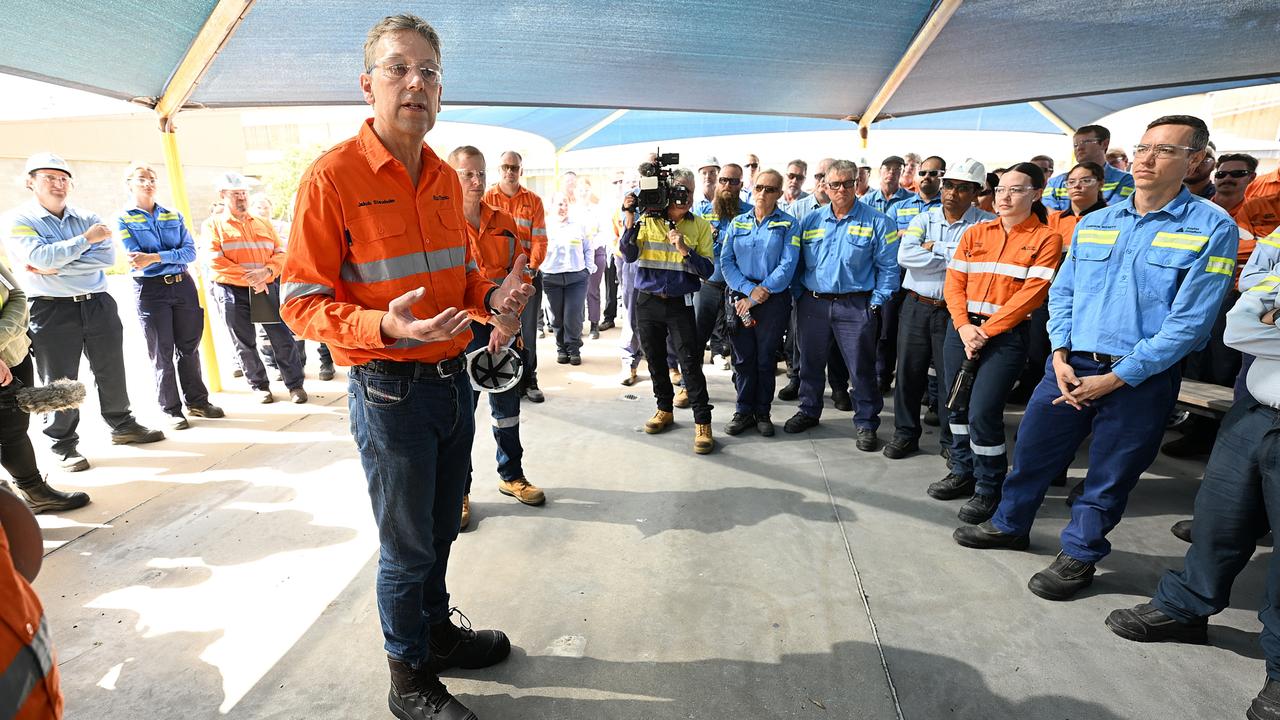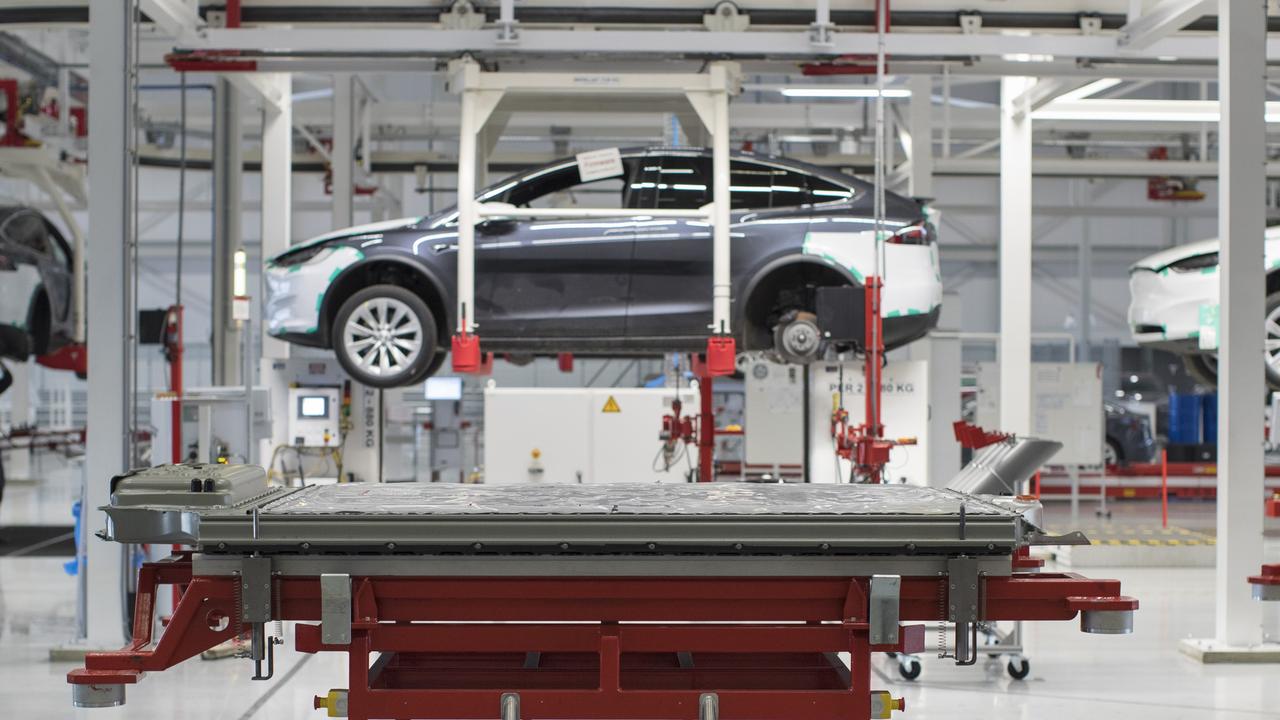How Rio Tinto is rewriting the rules in lithium powerplay
The mining giant’s $10bn bet has electrified the struggling industry. However, Rio will bring a different mindset to lithium.

Business
Don't miss out on the headlines from Business. Followed categories will be added to My News.
Not all lithium is created equal. Sometimes the soft, greyish metal is found in rocks, but mostly the richer deposits lurk in brine pools found just below the surface of the earth.
The commodity – if you can call it that – is fairly common in the Earth’s crust, and deposits are usually small and scattered.
This means digging the raw material out of the ground or evaporating it from pools doesn’t get cheaper the more you mine.
And like aluminium, there’s a complicated, multi-step process to upgrade the raw lithium into something usable.

Throw in an immature and highly unpredictable open market, and that is what has made lithium so unappealing to the big global miners. Until now.
In many ways, Rio Tinto chief executive Jakob Stausholm has placed his biggest bet since taking charge of the miner more than three years ago. He has just slapped down $US6.7bn ($10bn) in cash for a commodity that can barely stand on its own feet.
Rio’s friendly buyout of Australian-US Arcadium is a watershed moment for lithium. It marks the first of the top-tier miners to move into the market in a material way. And it comes in the middle of a price crash.
Boom bet
The Danish-born Rio boss is a trained economist, but he is putting his faith in chemistry.
Lithium has unmatched energy density, efficiency and delivery in high power demand situations. That’s why it’s the go-to source for electric vehicles and big batteries. And the maths are simple, as the world spends more on green energy we need more lithium batteries.
This is a boom that is going to last decades, Stausholm says.
However, the market today is oversupplied with refined lithium and while EV car sales are increasing, they are nowhere near the bullish growth projections of a few years ago.
In the commodity stakes, lithium is starting from a very long way behind. Lithium mining barely existed a few decades ago, and it is only just shedding its Wild West image.
But now it is dealing with the hangover of a severe price crash, with prices down 60 per cent in a year. The sector is made up of a handful of serious producers such as Arcadium, SQM, and Australia’s Liontown, Pilbara Minerals and MinRes.
There’s a long tail of juniors, including some who haven’t got a hope of securing a funding to develop mines.
Arcadium is a relatively new entity, it was only formed at the start of this year from last year’s merger of two sector majors Allkem and Livent. To show how far the lithium price has collapsed, the merged entity at the time was valued at just over $US10bn. Rio has paid a little under half of that.
Rio’s bet centres largely around the so-called closed loop that Arcadium has to offer. It mines the lithium and is building the manufacturing facilities that then turns the raw materials into a battery-grade lithium. Adding to the attraction is it is building out a refining plant in North Carolina and Canada’s Quebec. This qualifies it for billions of dollars of government subsidies. It also gives the US car industry an alternative to Chinese refining capacity. Arcadium counts Tesla, Panasonic, BMW, General Motors and Ford as major customers.
The key to make it work for Rio is having Arcadium as a one-stop shop from mining to battery grade material. So this is different from developing a dig-and-sell spodumene business of the raw lithium.

Stausholm tells The Weekend Australian, in looking at the entire lithium market, Arcadium “is the best business model we could see”.
The brine extraction comes with higher grades, and this puts Arcadium at the bottom of the cost curve. And according to the Rio boss, this will make the difference as higher cost output from other producers hits the market in the coming decade.
Stausholm’s big bet is forcing many to rethink on lithium.
Rio’s hefty 90 per cent premium to Arcadium’s pre-bid value was enough to put a rocket under rival lithium stocks. “It does give a lot of credibility to a sector that is probably oversold,” one executive at a rival miner says.
Rio first got a foot in lithium through its acquisition of a prospective mega-deposit in eastern Serbia more than two decades ago.
But the path was through borates (an element that sometimes coexists with lithium). At the time there was next to no market for lithium, with borates attracting all the attention for its use in helping to make glass heat-resistant, making it ideal for smartphones.
Then, as the energy transition became real, Rio quickly concluded there was far greater value in lithium for batteries.
Power shock
Jadar is a long way from being developed, with the project mired in political gridlock. Rio is hopeful of getting moving construction by the end of this decade, however Stausholm hedged his position two years ago, buying the undeveloped Rincon project in Argentina for $US825m.
Still, the vertically integrated Arcadium which has producing and processing capacity nearby Rincon clearly represents a more compelling Plan A for the Rio boss.
The move on Arcadium increasingly defines Rio against rival BHP. Rio is already deep in manufacturing given it is one of the biggest Western producers of aluminium.
Arcadium, which will be developing refining capacity for battery-grade lithium, now puts Rio even closer to its end customers, namely carmakers. BHP by contrast specialises in upstream only: digging up and shipping.

This is consistent with a long held view in mining that the best profit margin is the first one – and that’s at the mine site.
Some see Rio as paying full price for a depressed asset. And while no other bidders emerged, it is understood there was serious concern inside Rio it would face competition for Arcadium from a less obvious rival: big oil.
US giant ExxonMobil is drilling for lithium in the US and wants to become a major supplier of battery grade material to EV makers by early next decade. Other names looking at lithium include Equinor and even Argentina’s state-owned oil company YPF.
While lithium markets remain in such a state, Stausholm believes this is precisely the time to strike. This view, however, will hinge on the idea that oversupplied markets can’t get any worse from here.
Stausholm is banking on demand for lithium and battery materials to steadily pick up and by the end of the decade the market will flip from a surplus to deficit and this will lead to a double-digit growth rate to 2040.
The cash being spun out of his big iron ore and copper machine means he can ride out the downturn. A company the size of Rio also brings much lower funding costs and scale to the further development needed to get Arcadium’s refining and processing plants up and running.
“Lithium is one of the fastest-growing markets today and is expected to reach an even greater scale in the coming decades,” Stausholm says. “We have been saying for many years that we want to build a lithium business. But we wanted to build it at the right time and as competitively as possible.”

Already with aluminium, copper, and the iron ore, Rio supplies 40 per cent of the material in an EV battery. Lithium at scale will now see it dominate the battery supply chain.
Stausholm says he is committed to developing Rincon, with a proposal going to the board by the end of the year. Jadar too remains on the table. However, many believe these could be pushed back. The expansion levels available today in Arcadium will be lot cheaper than the billions needed to build Rincon from the ground up.
There are still plenty of risks for Rio in getting into lithium. The biggest of this is the expected recovery in demand for lithium doesn’t eventuate.
At the same time, it faces a structural risk like nickel markets. There is increasing and high quality supply now coming out of Africa that is also taking the market by surprise. This means it could take much longer for the market to swing back in balance.
Second, there’s plenty of project risk. Arcadium has a lot of capex demands, and refining plants are particularly complex that are difficult to get right.
Finally, it significantly raises Rio’s country risk. Relations between Rio Tinto and Argentine President Milei are currently warm. But Argentina has a difficult economic road ahead of it.
Still, Arcadium chairman Peter Coleman, the former Woodside boss, says Rio will again energise an industry that is ripe for more consolidation.
“As you look at the market, you’ve now got a tier one player in the resource sector who is in the process of acquiring a set of foundation assets that will allow them to continue to grow the industry”.
More Coverage
Originally published as How Rio Tinto is rewriting the rules in lithium powerplay









